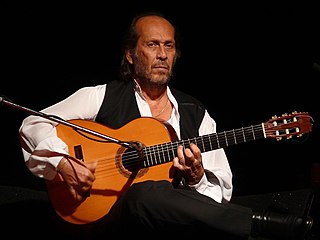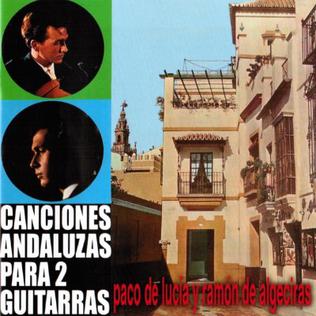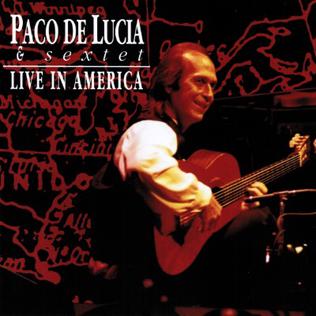Related Research Articles

Flamenco is an art form based on the various folkloric music traditions of southern Spain, developed within the gitano subculture of the region of Andalusia, and also having historical presence in Extremadura and Murcia. In a wider sense, the term is used to refer to a variety of both contemporary and traditional musical styles typical of southern Spain. Flamenco is closely associated to the gitanos of the Romani ethnicity who have contributed significantly to its origination and professionalization. However, its style is uniquely Andalusian and flamenco artists have historically included Spaniards of both gitano and non-gitano heritage.

Carmen Amaya Amaya was a Spanish Romani flamenco dancer and singer, born in the Somorrostro district of Barcelona, Catalonia, Spain.

Paco Peña is a Spanish flamenco composer and guitarist. He is regarded as one of the world's foremost traditional flamenco players.
Farruca is a form of flamenco music developed in the late 19th century. Classified as a cante chico, it is traditionally sung and danced by men. Its origin is traditionally associated with Galicia, a region in northern Spain.

Siguiriyas are a form of flamenco music in the cante jondo category. This deep, expressive style is among the most important in flamenco. Unlike other palos of flamenco, siguiriyas stands out for being purely Romani (Calé) in origin. Siguiriyas are normally played in the key of A Phrygian with each measure consisting of 12 counts with emphasis on the 1st, 3rd, 5th, 8th and 11th beats as shown here:

Francisco Sánchez Gómez, known as Paco de Lucía, was a Spanish virtuoso flamenco guitarist, composer, and record producer. A leading proponent of the new flamenco style, he was one of the first flamenco guitarists to branch into classical and jazz. Richard Chapman and Eric Clapton, authors of Guitar: Music, History, Players, describe de Lucía as a "titanic figure in the world of flamenco guitar", and Dennis Koster, author of Guitar Atlas, Flamenco, has referred to de Lucía as "one of history's greatest guitarists".
Rumba flamenca, also known as flamenco rumba or simply rumba, is a palo (style) of flamenco music developed in Andalusia, Spain. It is known as one of the cantes de ida y vuelta, music which diverged in the new world, then returned to Spain in a new form. The genre originated in the 19th century in Andalusia, southern Spain, where Cuban music first reached the country.

Iberia is a suite for piano composed between 1905 and 1909 by the Spanish composer Isaac Albéniz. It is composed of four books of three pieces each; a complete performance lasts about 90 minutes.
Juana la Macarrona was a Spanish flamenco dancer (bailaora).
The cante flamenco, meaning "flamenco singing", is one of the three main components of flamenco, along with toque and baile (dance). Because the dancer is front and center in a flamenco performance, foreigners often assume the dance is the most important aspect of the art form — in fact, it is the cante which is the heart and soul of the genre. A cante singer is a cantaor or cantaora.
This is a glossary of terms that relate to flamenco arts.
Mario Escudero, was one of a handful of Spanish flamenco guitar virtuosos who, following on the footsteps of Ramon Montoya, helped spread flamenco beyond their Spanish homeland when they migrated to the United States in the early 1950s. Along with others such as Sabicas, Carlos Montoya and Juan Serrano, Escudero helped forge the viability of solo flamenco guitar as a concert instrument, with lauded performances at New York's Carnegie Hall, Town Hall, and other venues. Invited to perform at the White House for President John F. Kennedy, Escudero was counted among the best in his era; Ramón Montoya called him "the best flamenco guitarist of this new generation."

El Concurso del Cante Jondo was a fiesta of flamenco arts, music, song, and dance, held in Granada in 1922. Conceived and initiated by composer Manuel de Falla, it enjoyed early and strong support from the poet Federico García Lorca. The two-day evening event was held outdoors at the Alhambra. The show included the best of well-known flamenco artists, but the contest's prize money was reserved for amateur performers.

Canciones andaluzas para 2 guitarras is the first of four collaboration albums by Paco de Lucía and Ramón de Algeciras.

El mundo del flamenco is an album by Paco de Lucía.

En vivo desde el Teatro Real is a live album by Paco de Lucía recorded on February 18, 1975 at the Teatro Real in Madrid, Spain. He was accompanied by his brother Ramón de Algeciras on stage.

Live in América is a live album by Paco de Lucía Sextet, the band formed by famous flamenco guitarist Paco de Lucía.

Rafael Riqueni del Canto, is a Spanish guitar player and composer. He is considered as one of the biggest names or “Maestros” in flamenco guitar history. At age fourteen, he won the two main national awards for flamenco guitar in Spain. As an adult, he has won the most prestigious flamenco music awards in Spain, including: Premio Andalucía de Cultura, Premio Nacional de la Crítica, Giraldillo a la Maestría de la XVIII Bienal de Flamenco y el Premio AIE. In 2017, he was awarded with XXXI Compás del Cante, this award is always referred to by the Spanish media as the "Flamenco Nobel prize".
Flamenco zapateado notation or Flamenco zapateado (foot-stomping) notation is a type of dance notation. It is the graphic representation of the sonorous and motor aspects of the particular movements of flamenco dancing that are produced by the action of zapateado or foot-stomping.
References
Enciclopedia universal ilustrada europeo-americana. Vol.70. ISBN 9788423945580 .